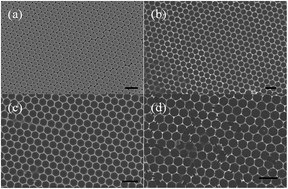Oxygen vacancy-related room temperature ferromagnetism in TiO2 nanohole arrays
Abstract
Room temperature ferromagnetism was observed in hole-like TiO2 nanostructure arrays prepared by a monolayer colloidal crystal template. The saturation magnetization (MS) is 0.46 emu g−1 for the as-grown array, which is stronger than that of pristine TiO2 magnetic semiconductors in other work. It is found that the MS exhibits a monotonous decrease with increasing annealing temperature. Results show that the ferromagnetism behavior of the TiO2 nanoarray is related to oxygen vacancies on the surface of nanoparticles, and MS is determined by the concentration of oxygen vacancies. This work will provide a facile way to fabricate magnetic semiconductor nanoarrays and tailor their ferromagnetism for the application in spin-based nanodevices.


 Please wait while we load your content...
Please wait while we load your content...